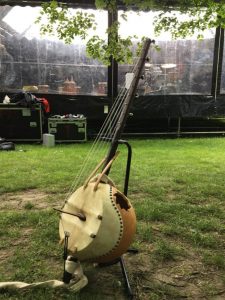 Now, what is that beautiful instrument, the ngoni, exactly and where did it come from? The ngoni or “n’goni” is a string instrument originating in West Africa. Its body is made of wood or calabash with dried animal (often goat) skin head stretched over it. The ngoni, which can produce fast melodies, appears to be closely related to the akonting and the xalam. This is called a jeli ngoni as it is played by griots at celebrations and special occasions in traditional songs called fasas in Mandingo.
Now, what is that beautiful instrument, the ngoni, exactly and where did it come from? The ngoni or “n’goni” is a string instrument originating in West Africa. Its body is made of wood or calabash with dried animal (often goat) skin head stretched over it. The ngoni, which can produce fast melodies, appears to be closely related to the akonting and the xalam. This is called a jeli ngoni as it is played by griots at celebrations and special occasions in traditional songs called fasas in Mandingo.
Donso ngoni
Another larger type, believed to have originated among the donso (a hunter and storyteller caste of the Wasulu people) is called the donso ngoni. This is still largely reserved for ceremonial purposes. The donso ngoni, or “hunter’s harp” has six strings. It is often accompanies singing along with the karagnan, a serrated metal tube scraped with a metal stick. The donso ngoni was mentioned by Richard Jobson in the 1620s, calling it the most commonly used instrument in the Gambra (Gambia). He described it as an instrument with a great gourd for a belly at the bottom of a long neck with six strings. The smaller kamale ngoni has entered popular musical styles such as Wassoulou music.
The ngoni is many centuries old
The ngoni is known to have existed since at least 1352, when Ibn Battuta, a Moroccan traveller reported seeing one in the court of Mansa Musa. It is believed to have evolved into the banjo in North America after Mande slaves were exported there. Battuta also reported the balafon. A book written by English musician Ramon Goose about the Ngoni describes its known history, tunings and a beginner’s guide to playing the instrument.
Kamale ngoni
The kamale ngoni or “young man’s harp” is claimed to be invented by the musician Alata Brulaye around the 1950s and 1960s in Mali. It became popular in the Wassoulou region and contributed to the rise of Wassoulou music in the 1970s and 1990s. Musicians traditionally tune this harp using pentatonic scales. There are however exceptions, like Adama Yalomba, who are exploring new horizons and applying heptatonic scales transforming and influencing the younger generation.
Ngoni, not to be mistaken for a kora
Kamale ngoni is smaller than, and tuned a fourth higher than, the traditional pentatonic donso ngoni, which is the predecessor of the kamale ngoni. Both the kamale ngoni and donso ngoni resemble and share their basic design with the Manding kora, but the kora has a wider range (often up to four octaves) with many more strings that are tuned diatonically, while the kamale ngoni and donso ngoni have ranges of around an octave (or slightly more, in the case of the kamale ngoni), and are tuned pentatonically.
During decades both harps followed similar orgonology using a resonance body made of calabash rather than wood such as the traditional lute ngoni. This West African harp was initially played using only six strings but later that number was increased to eight, ten, twelve, fourteen, sixteen and eighteen strings.
Some notable ngoni players
- Banzumana Sissoko
- 马达额
- Yoro Sidibe, donsongoni
- Youssoupha Sidibe
- Ko Kan Ko Sata, the first and possibly only female exponent and performer of the kamalengoni
- Leni Stern, American jazz guitarist who incorporates ngoni into all her current projects, including with the Mike Stern Band
- Issa Bagayogo
- Dicko Fils
- Moriba Koïta
- Bassekou Kouyate
- Andra Kouyaté
- Baba Sissoko
- Mamadou Kouyate, player of the little-known bass ngoni, appeared at The 2013 Proms
- Abdoulaye Kone from Sidi_Touré Band
- Mamah Diabaté from Rokia Traoré Band
- Adama Dicko
- Cheick Hamala Diabaté, a grammy nominated, internationally playing artist who also plays the banjo
- Indiana Carsin
- Joris Feuillatre
- Michiel Moerkerk
Source: Wikipedia, this content is released under Creative Commons BY-SA license. Adapted to improve readability.